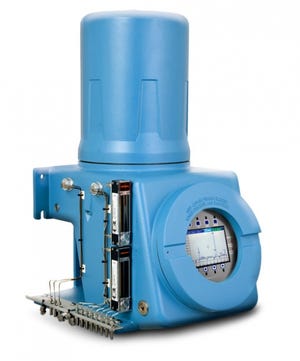Measuring the quality of landfill gas with gas chromatography.
September 13, 2012
By Michael Gaura, Product Marketing Manager, Emerson Process Management, Rosemount Analytical
Landfills generate a valuable by-product from the decomposition of waste materials present at their facilities – a methane rich gas stream that can be used to fuel boilers, dryers and heaters, power generators for engines and turbines, or even be sold into a natural gas network. Using the gas in any of these applications is preferred over the historical practice of flaring or venting. Flaring and venting represent environmentally irresponsible practices, as both contribute to greenhouse gas development with no positive benefit.
To utilize landfill gas (LFG) in its operations or to sell it to a natural gas network, the landfill operator must understand the components present in the gas stream as well as their concentrations. A gas chromatograph makes this analysis possible.
Gas chromatography is one of the most widely used techniques for analyzing gas mixtures. Some of the advantages of chromatography are the range of measurement — from parts per million (ppm) levels up to 100 percent — and the ability to detect a wide range of components. A chromatograph also makes it easy to replicate previous measurements.
Regardless of the application, gas chromatographs all share the same fundamental components and theory of operation. The sample must be cleaned and dried, and the pressure controlled through an effective sample handling system. The analytical components of the gas chromatograph are contained in a temperature-controlled oven. Various chromatographic columns separate the individual components of the sample. Low-volume, multi-port analytical valves control the sample injection and manipulate the analytical flow path. Detectors measure the concentration of each component as it elutes from the columns.
The detector signal is processed by a controller that produces a readout called a chromatogram and calculates individual concentrations and other physical properties of the sample. Finally, the controller communicates its findings through serial or discrete outputs. A typical gas chromatograph used in landfill applications is shown in Figure 1.
Methane and carbon dioxide (CO2) are often the two components with the highest concentration levels found in LFG applications. Oxygen, nitrogen and water are typically found also at percent levels. Other components, such as ammonia, silanes and hydrogen sulfide (H2S) also may be present at concentrations of several hundred ppm.
Knowing the concentrations of each of the typical LFG components determines the appropriate method of gas treatment, blending or usage. The concentrations also may be required as part of permitting, as defined by a local air quality board or environmental agency.
Some general guidelines for landfill gas usage include:
• Landfill gases with high-energy content and low impurities may be sold into a natural gas network.
• Equipment fueled by LFG meeting a defined range of energy values (CV or BTU) will ensure efficient and reliable operation. Excursions outside of these defined ranges will result in equipment damage or reduced performance.
• If the non-methane components of the LFG are too high, it may be too “lean” for proper engine performance, requiring the addition of natural gas or another fuel source.
• If the H2S content is higher than the equipment rating, pipeline specification or regulatory agency-permissible level, it will need to be removed. The only way to safely determine the continuous H2S level is to use an on-line analyzer, as manual testing may miss variances or present unsafe concentrations for human exposure.
• Common H2S removal methods include water washing, amine absorption, pressure swing adsorption (PSA) or turbo expander usage. Regardless of the system used, monitoring both the inlet “sour” gas and the outlet “sweet” gas is required to ensure efficient operation of the H2S removal process. A sudden change, or even a gradual increase, of the H2S concentration in the sweet gas, indicates that the removal system requires inspection or maintenance. A process gas chromatograph that monitors the H2S concentration at the H2S removal outlet can identify off-specification gas early, preventing contamination of an entire batch.
• High oxygen (O2) levels can indicate that a serious operational safety risk is present or may indicate an issue with the landfill’s degradation process.
Safety risk: Oxygen content above 0.5 – 1 percent (by volume) is often an alarm point, with concentration above 4 percent being a trigger point to shut down gas production. The concern with elevated oxygen levels is that they change the LFG from a “flammable” gas (requires air and ignition source to burn) to an “ignitable” gas (only requires an ignition source).
Operational concern: Oxygen needs to be consumed during the early aerobic phase of decomposition, before the anaerobic production of methane can begin. Presence of elevated oxygen levels at the landfill gas outlet may indicate an issue with the anaerobic process.
For landfill gas suppliers and end users, contracts and permits often require that energy values and individual component concentrations fall within defined ranges. To ensure efficient and safe operation of the landfill is ongoing, and to guarantee that the contract specification and reporting requirements are being met, a gas chromatograph can be installed to continuously provide the current values of the individual components or energy content and allow the operator to realize maximum value from the landfill gas.
Michael Gaura is product marketing manager with Emerson Process Management, Rosemount Analytical. He can be contacted at 713-396-8880 or www.RosemountAnalytical.com.
You May Also Like


